Dieting and Weight Loss
Starved for 11 months
Nov 1959: Helen Putnam, a performer who went by the stage name "The Ten Ton Fun" (her theme song was 'All of me') was accepted into a weight-loss experiment conducted by Frank Tullis of the University of Tennessee. For the next 11 months she was restricted to a liquid diet consisting of nothing but black coffee, tea, water, and 900 calories a day of a milk and soy-based formula."I thought I was starving. I thought the doctors didn't know what they were doing," she said. She wept. Some days she sulked in her room. On others she ranted and raved and several times threatened to leave.
She dropped from 318 pounds to 151, and in doing so became the first woman to ever complete a metabolism experiment of this kind.
I wonder if she managed to keep it off. I haven't been able to find any follow-up info about her.
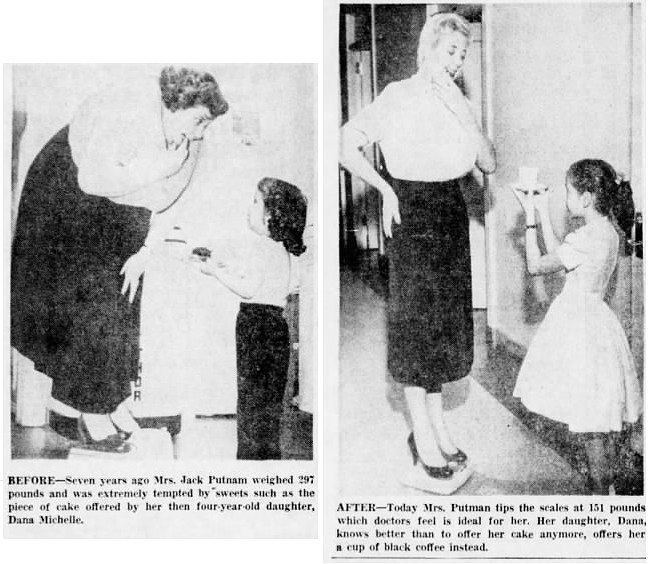
Pittsburgh Post Gazette - Jan 21, 1961
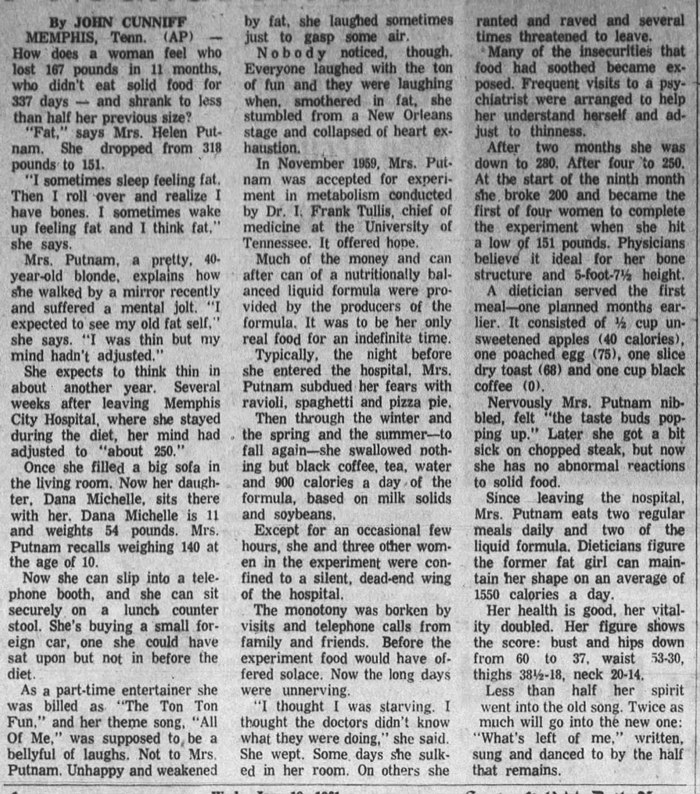
Springfield News Leader - Jan 18, 1961
Posted By: Alex - Mon Nov 06, 2017 -
Comments (3)
Category: 1960s, Dieting and Weight Loss
Weighing the Mayor
The town of High Wycombe in England has an ancient custom of weighing their mayors, first upon taking office and again at the end of their term. To have gained weight is taken as evidence that they've grown wealthy at the taxpayer's expense. It's like an ancient form of fat-shaming.In the 1950s, the mayor of Minneapolis, Eric Hoyer, decided to adopt this custom. He even arranged to have the official scales flown in from High Wycombe. He apparently was pretty confident that he'd lost weight, but according to the scales he had gained some. He blamed the extra weight on the ceremonial costume he was wearing for the occasion.
It's an interesting custom. Perhaps we should weigh more politicians periodically. Such as an annual weighing of senators and the president.
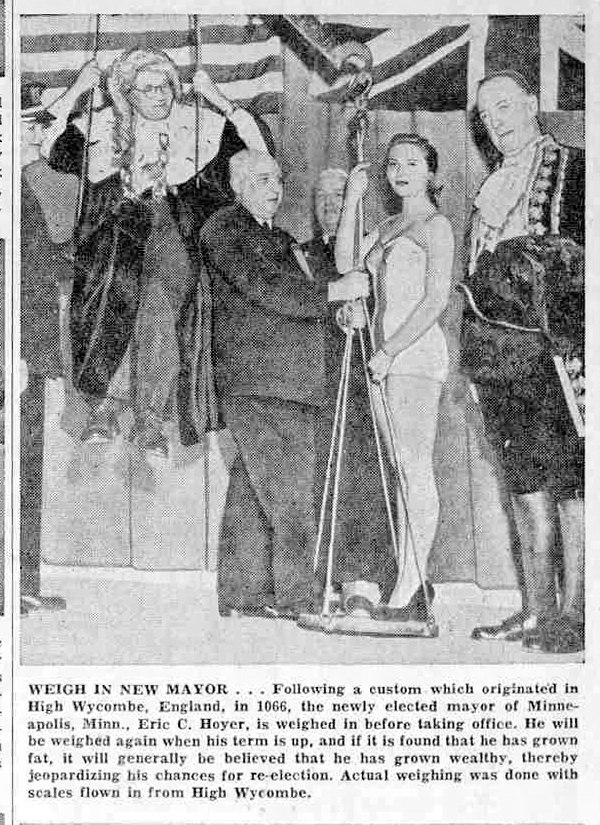
Pleasant Grove Review - Jan 4, 1952
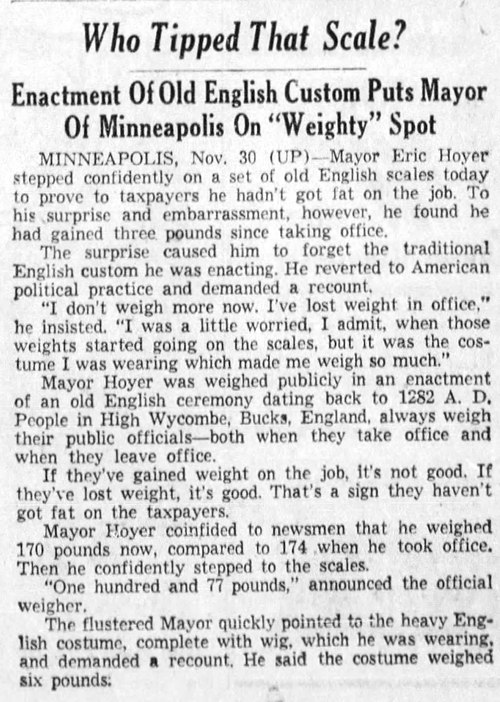
Cincinnati Enquirer - Dec 1, 1951
Posted By: Alex - Mon Oct 16, 2017 -
Comments (6)
Category: Politics, 1950s, Dieting and Weight Loss
Sexy Pineapple Diet
This diet from 1970 was simple. Just eat only pineapple for two days every week. On the other days you can eat whatever you want. The book is apparently quite a rarity, because I haven't been able to find any used copies for sale.Over at vice.com, a guy recently tried the diet and claims that he lost 1 kilogram (2.2 lbs) in three days. Which, actually, isn't a lot. Evidently, he was able to find a copy of the book. He also discovered that one of its authors, Sten Hegeler, was still alive, 93 years old. When contacted, Hegeler admitted that not a lot of deep thought went into the concept of the diet:
And a bonus for linguaphiles: The word "erogetic" appears to have been invented for this book. I'm not sure what it means.
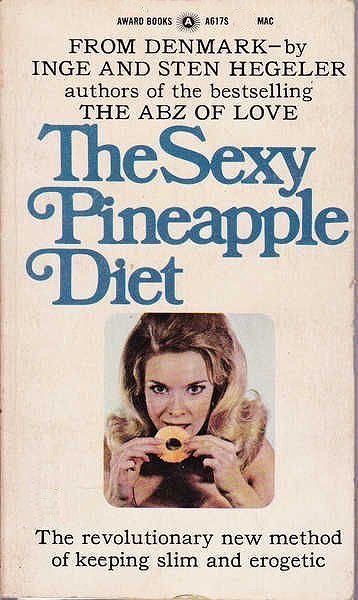
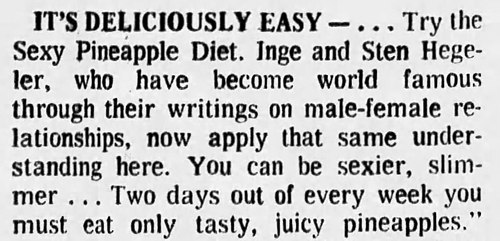
Fort Myers News-Press - Sep 16, 1970
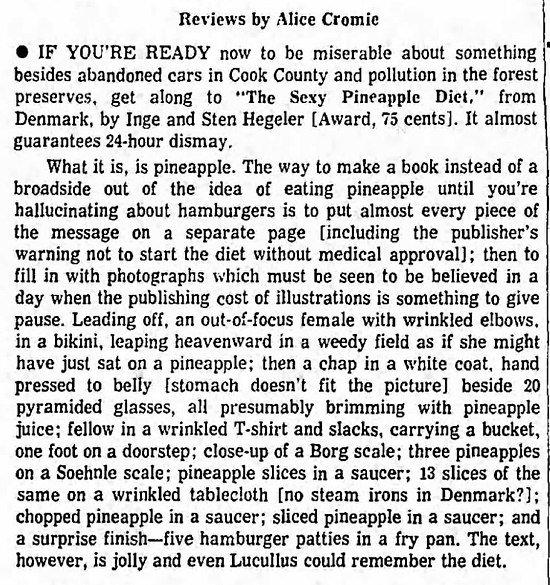
Chicago Tribune - Nov 5, 1970
Posted By: Alex - Wed Aug 09, 2017 -
Comments (6)
Category: Food, 1970s, Dieting and Weight Loss
Vision-Dieter Glasses
The Vision-Dieter glasses were weight-loss eyeglasses, created by Arkansas entrepreneur John D. Miller who sold them for $19.95 each. They had a different lens for each eye: one brown and the other blue. Miller claimed that the different colors caused a low-level of confusion in a person's subconscious that led to a loss of appetite, and thus weight loss. In 1982 the U.S. attorney stopped the sale of the glasses because Miller hadn't registered them with the Food and Drug Administration. Also, there was no evidence they actually worked as a diet aid.
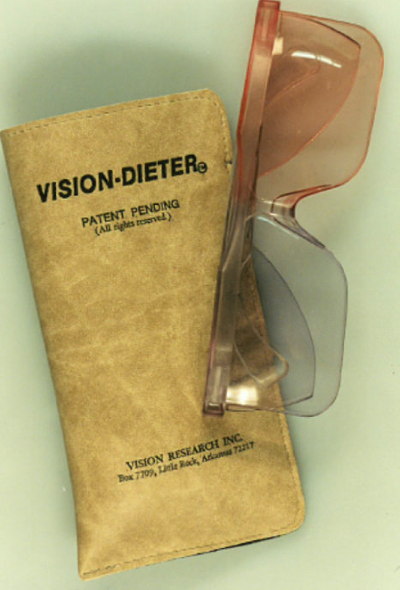
image source: Flickr
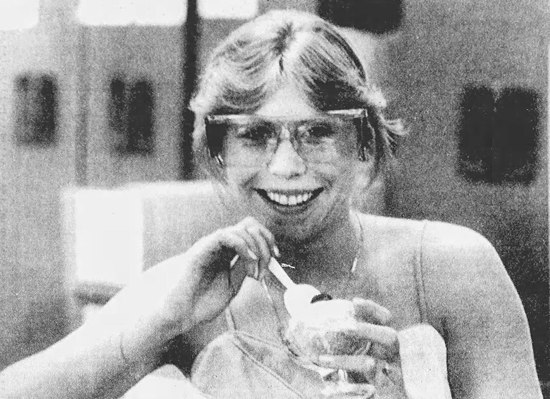
FDA employee Karen Kowlok models Vision-Dieter glasses
Newport News Daily Press - Mar 21, 1985
From the Wilmington News Journal - Aug 6, 1982:
Perhaps tinted eyeglasses could reverse the attraction to food by affecting the subconscious, Miller hypothesized. And he went to work.
The experiments began with employees of one of his enterprises, the Miller Vision Centers. Soon the research was extended to his patients.
At first, the results were mixed. He had chosen the wrong colors. Then he hit upon crimson brown and royal blue.
"It's crazy. I can't tell you exactly how, but it works," Miller said.
Soon testimonial letters were coming into Miller's office by the dozens. In virtually every case, people who wore the glasses said they weren't eating as much. He conducted control experiments with the help of a psychologist and claimed a 97 percent success rate.
Posted By: Alex - Thu Jun 29, 2017 -
Comments (1)
Category: Food, 1980s, Dieting and Weight Loss, Eyes and Vision
The Mayonnaise diet
What exactly is the mayonnaise diet? Googling the term produces various vague references to such a thing, but no specifics. So, like the Dial-A-Dietitian, I have no idea what this diet involves... beyond a lot of mayonnaise and eggs.My guess is that it was either an alternative name for the Atkins Diet, or an eccentric variant of it, since the book Dr. Atkins' Diet Revolution first came out in 1972, which makes the timing about right for this person inquiring about a mayonnaise diet in 1974.
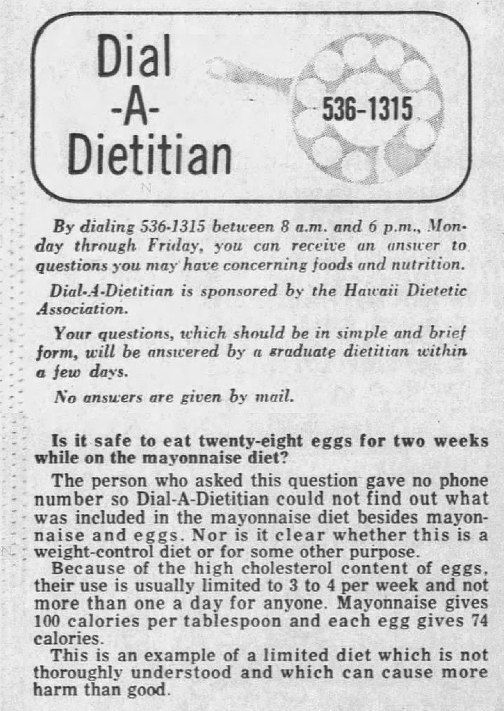
Honolulu Star Bulletin - June 19, 1974
Posted By: Alex - Tue Jun 13, 2017 -
Comments (3)
Category: Food, Mayonnaise, Dieting and Weight Loss
The Tubby Hubby Diet
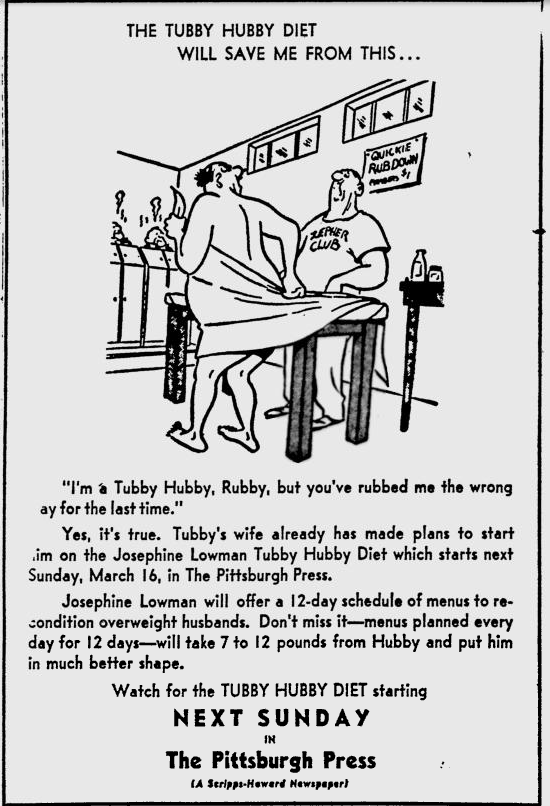
Original ad here.
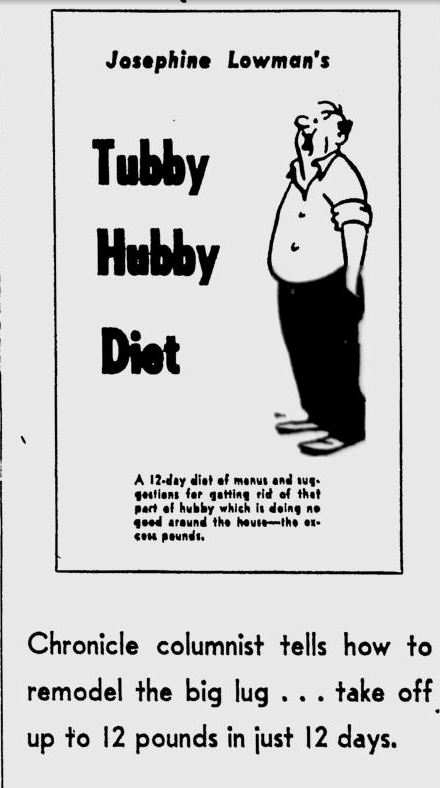
Original ad here.
I just cannot believe the arrogant sexism and objectifying behavior of Josephine Lowman! I feel cheap and soiled, on behalf of all tubby hubbies.
LATE ADDITION TO THE POST: I could not resist adding this new term I just thought of: "schlub-shaming."
Posted By: Paul - Thu Dec 01, 2016 -
Comments (1)
Category: Body, Dieting and Weight Loss, Public Humiliation, 1950s
Fabulous Lady Diet Food
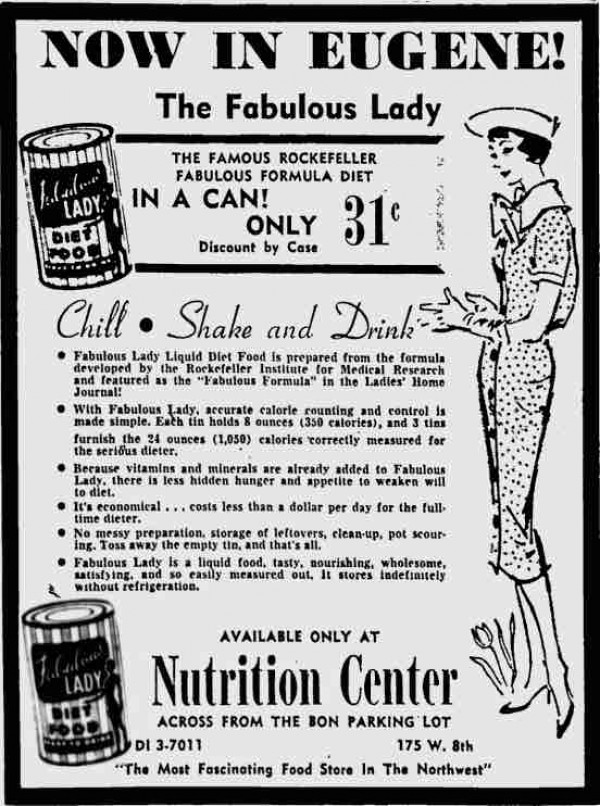
This is one of those rare instances where I can learn nothing on the internet about an old-time product. I suspect it was simply a forerunner of such drinks as Metrecal. If anyone can discover the secret ingredients of this drink, or even more press about it, they will be a master sleuth!
Original ad here.
Posted By: Paul - Thu Oct 20, 2016 -
Comments (6)
Category: 1950s, Women, Dieting and Weight Loss
Diet Yourself to Death
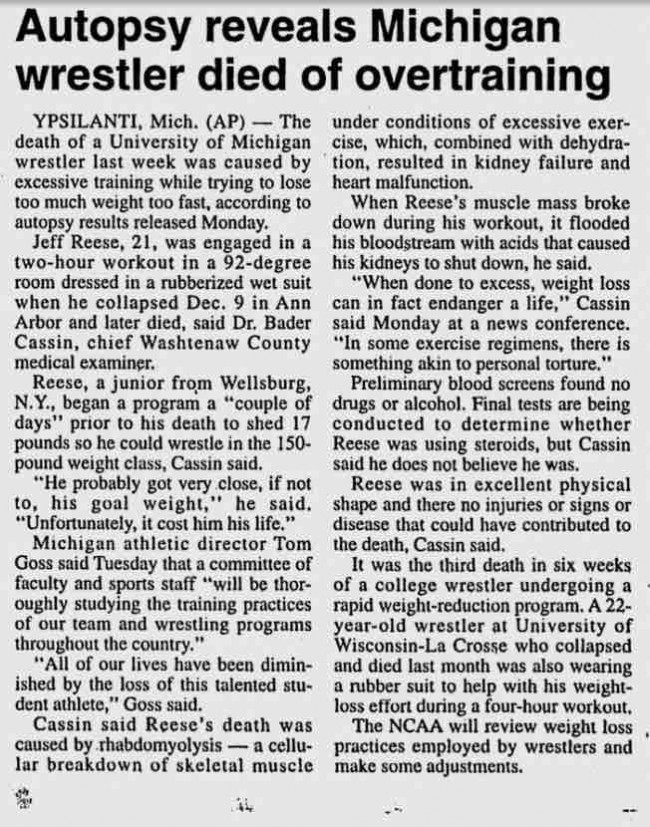

So this is kind of a "good news/bad news" story then?
Original article here.
Posted By: Paul - Wed Apr 20, 2016 -
Comments (4)
Category: Death, Sports, 1990s, Bodybuilding, Dieting and Weight Loss

| Who We Are |
|---|
| Alex Boese Alex is the creator and curator of the Museum of Hoaxes. He's also the author of various weird, non-fiction, science-themed books such as Elephants on Acid and Psychedelic Apes. Paul Di Filippo Paul has been paid to put weird ideas into fictional form for over thirty years, in his career as a noted science fiction writer. He has recently begun blogging on many curious topics with three fellow writers at The Inferior 4+1. Contact Us |




